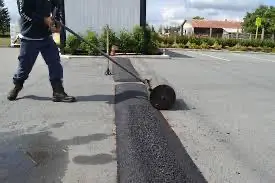Speed bumps are essential for enhancing road safety, effectively slowing down traffic and protecting pedestrians. However, improper installation can lead to unwanted consequences, including potential damage to vehicles and driver dissatisfaction. Precision in installation, design, and maintenance is crucial to creating speed bumps that balance safety and vehicle comfort. In this guide, we’ll explore key considerations for successful speed bump installations, offering insights from paving experts to ensure they achieve the desired traffic-calming results.
Speed Bump Paving and Installation
Proper speed bump installation is essential to minimize vehicle damage while effectively reducing speeds. A precise installation process, guided by best practices, is critical. Factors like road conditions, traffic volume, and the types of vehicles using the roadway influence the choice of materials and design. For instance, some situations might require durable asphalt speed bumps, while others could benefit from the flexibility of rubber. There are different types of speed bumps, each with its cons and pros. A professional paving company should conduct a thorough assessment of the site to select the right materials and ensure an optimal design for long-term performance.
Importance of Signage and Road Markings
Signage and road markings are key components in successful speed bump installation. Effective warning signs and visible road markings alert drivers in advance, giving them ample time to reduce speed and prepare for the bump. For better visibility in low-light conditions or adverse weather, reflective paint or markers are recommended. Strategic placement of signage not only increases driver awareness but also minimizes sudden braking that could cause vehicle damage.
Speed Bump Design Considerations
The design of a speed bump significantly influences its effectiveness and how vehicles respond to it. Finding the right balance between height and width is crucial for slowing down traffic without causing discomfort or damage to vehicles. A typical speed bump ranges between 3 to 4 inches in height, with a gradual incline to reduce jarring impacts. Additionally, if the road is used by emergency or public transportation vehicles, the design should accommodate their needs without compromising the safety of everyday drivers. A paving contractor should ensure the specifications are tailored to the unique requirements of the road.
Alternative Measures for Traffic Calming
While speed bumps are a popular traffic-calming measure, they are not always the best fit for every situation. In some cases, alternatives like speed tables, chicanes, or textured pavement may be more effective. Speed tables, for instance, have a longer, flatter profile that reduces speeds without the abrupt impact of a traditional speed bump, making them a better option for roads frequented by larger vehicles. An experienced paving company can recommend and install alternative solutions that match the specific conditions of the road and traffic.
Maintaining Speed Bumps
Installing a speed bump is only the first step; regular maintenance is equally important. Over time, speed bumps can develop cracks, uneven surfaces, and general wear, which can lead to vehicle damage if not properly maintained. Routine inspections and timely repairs by a qualified paving company to ensure that speed bumps remain effective and continue to promote safety without causing unintended consequences.
Installing speed bumps is a thoughtful process that requires careful consideration of design, materials, and the specific needs of the roadway. Proper signage, clear road markings, and regular maintenance are all key factors in ensuring a speed bump serves its purpose without creating unnecessary challenges for drivers. A trusted paving expert can guide you through the process, helping to create safer and more efficient roadways for everyone while maintaining a comfortable driving experience.
At Burnaby Blacktop, we’re committed to the paving and installation of speed bumps that prioritize safety and minimize adverse effects on vehicles. Through careful consideration of installation practices, design parameters, signage, and maintenance, as well as the road, the traffic, and the pedestrians, we strive to create safer and more efficient roadways for all users. Contact our paving experts and request a free quote
